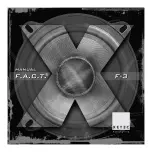
2.7 Bass lowpass
This option defines the upper frequency limit, that means, at what
frequency the bass range rolls off. (60 Hz - 300 Hz). Middle position
is 90 Hz.
2.8 Mode front / rear
The switch mode front / rear is exclusively for the use of
car
EQfi modules.
CONTROL ELEMENTS INSIDE OFTHE
XETEC
F.A.C.T. fi F-3.
2.9 Ground lift
The ground lift jumper on the board near the inputs are normally set
to ground connect (unbalanced).
In case of disturbances, as alternator noise, you take the alternative
position called grond lift (balanced) to eleminate those distur-
bances.
2.10 Woofer EQ jumper (near to woofer highpass (2.4) adjuster)
In delivery status these jumpers are in position Woofer EQ .
This causes a little sinking in the upper middletone range, which is
normally overemphasized by most woofers, because of their voice
coil inductance. In the position EQ off the woofer signal passes as
usual.
2.11 Option carEQfi module carEQfi is a patented signal processing and
comes in a module. carEQfi modules are available for various car
models. Basically they are a pre-adjusted equalizer which compensates
the typical acoustical environment in a car, determined by several
resonances and reflections. Using carEQfi
avoids complicated
measurements, and is a plug-and-play improvement for every sound
system.
Who needs crossovers?
The ideal loudspeaker is working Fullrange , that means, it can reproduce
all frequencies with the same quality.A dream.This problem is usually solved
dividing the audio spectrum into frequency ranges that fit specially designed
speakers that are able to reproduce at least a certain part of it:
Woofers for low and tweeters for high frequencies. Together they are
supposed to cover the whole spectrum then
But a tweeter is unable to reproduce low frequencies, as those have high
energy and it will be immediately destroyed, and a woofer is unable to
reproduce high frequencies above a certain limit due to it·s inertia, it simply is
too slow.
Please note: both jumpers must be in the same position!
Please note: both jumpers must be in the same position!
So, a new problem is caused. We must try to feed the woofer and tweeter
with only the frequency spectrum they easily can handle. Thus we use
a crossover network , a frequency divider or separator called crossover.
That causes the third problem: Passive crossovers are used behind the
amplifier and thus need big components to handle the amplifier·s output
power.
Our more intelligent way is, to accomplish the separation of high and low
frequencies BEFORE they pass the amplifier. This way the possibilities of
correction and perfect matching in crease significantly.
This principle is called active mode , and we have re-defined it in our
concept.
Just keep your speakers ! (...and activate them with F.A.C.T.fi F-3!)
Why active ?
Active crossovers offer many options to correct and positively influence the
signal. So, you can increase the performance of your existing passive system
enormously.
1.
Passive crossovers cause rather high losses due to their high
impedances compared to the output resistance of the amplifier.
Even the good damping factor of a high quality amplifier that might
be 200 will be reduced by the passive crossover·s losses to ridiculous
4,8 at the woofer
and even a damping factor of 1000 will be
reduced to 4,9 finally
. and, by the way, 10.000 will also result in
only around 4,9! The damping factor is the measure for the control
of the amplifier on the connected speaker. Minimum requirement is
>100
2.
Damping factor is very expensive, save it and use
!
3.
Passive crossovers never match the speakers sufficiently. Their
component·s tolerances /- 10
20% successfully prevent
that. Passive components like resistors, capacitors and inductors are
only available in certain values and have to be used by compromise.
4.
The Tweeter Level is only roughly adjustable in passive x-overs
(co3, 0, -3 dB) that·s more than coarse and far away from
the needs or even fine-tuning .
5.
The system·s phase relations are fully determined by chance
depending on the mounting locations of the speakers, their distance
and relative angles. That means that phase adjust of woofer and
tweeter cannot be influenced at all using passive x-overs.
6.
So called
subwoofer-
and
midbass-crossovers
cause the
highest losses caused by component·s impedances and high energy.
F.A.C.T.fi
F.A.C.T.fi F-3
1
4
Summary of Contents for F.A.C.T. F-3
Page 1: ... ...







